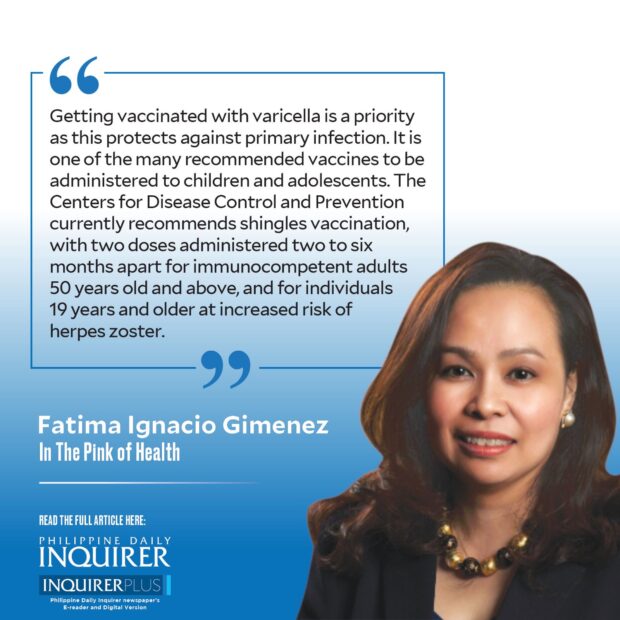
“Please turn on your video so that you could better see what I am describing.”
A few years ago, a sibling had called to describe a lesion she had on her forehead. She was experiencing an intense headache and asking for advice on what medicine to take. Upon seeing the location, I got extremely worried and thought of how I could get to her. She was in the United States on vacation, and prescription medicine would be needed.
“Would you be willing to accept an infectious referral for possible admission? A relative has some nasty, painful lesions on the face and neck and the parents are contemplating on bringing her to Manila.” Scanning the picture sent, I was unsure as the lesions were bullous in character. It was time to call on my friendly pediatric dermatologist to validate the suspicion.
“Ma’am, I am sorry but the patient did not disclose the information.” The pediatric infectious disease fellow had updated me that our adolescent patient, a diagnosed case of lupus nephritis, was transferred to the isolation ward and contact tracing done. This decision was made after she had made her rounds and noted that the patient was having low-grade fever and, upon repeat physical examination, had vesicular eruptions on the thigh. Upon prehistory, the watcher shared that the patient apparently had a chickenpox infection at three years old and did not receive any vaccination. Days before, he had been complaining of thigh pain prior to the appearance of the vesicles.
All three are cases of herpes zoster, more commonly known as shingles. You may either have heard of it, or unfortunately have experienced it. The causative agent is the varicella-zoster virus. Varicella or chickenpox results from a primary infection. During the course, the virus establishes itself in the sensory ganglia of the host and lays dormant, to be later reactivated in states of immunosuppression and manifest as shingles. Triggers mentioned in literature include emotional stress, acute, or chronic illness, malignancies, or being under immunosuppressive medications.
Now that we know that herpes zoster arises from a previous infection with varicella, how contagious can one be? The main mode of transmission for herpes zoster would be from close contact. Touching or inhaling virus particles from the lesion could result in an infection. For those who do not have protection from vaccination or have a natural infection, this could result in an individual coming down with chickenpox and later in life, being at risk for shingles and its complications. The chances of this happening increase as one gets older though there have been reports occurring in the pediatric population.
How to tell one from the other? In most instances, it is diagnosed clinically. A history of varicella plus the character and distribution of the lesions are important clues. In shingles, these are unilateral and involve a single dermatome, as opposed to varicella wherein the lesions are usually distributed in all areas of the body and are in various stages of eruption. Commonly involved would be the cervical, thoracolumbar, trigeminal, and ophthalmic dermatomes. Prior to the appearance of these cutaneous manifestations, there is a period of burning pain, fever and headache, malaise, and as personally experienced by my sibling, photophobia. What was unnerving in her case was the possibility of encephalitis or loss of vision by virtue of where it appeared, on her forehead. Pain can be intense, unresponsive to the usual medications, and can be very debilitating. You may have heard of the term postherpetic neuralgia or PHN, which is the most common complication and, as the term suggests, is pain that can be felt even after the lesions have healed. Aside from these, there has been mention of individuals having hearing loss, pneumonia, or dying from herpes zoster with disseminated disease being seen in immunosuppressed populations.
Prevention: Getting vaccinated with varicella is a priority as this protects against primary infection. It is one of the many recommended vaccines to be administered to children and adolescents. The Centers for Disease Control and Prevention currently recommends shingles vaccination, with two doses administered two to six months apart for immunocompetent adults 50 years old and above, and for individuals 19 years and older at increased risk of herpes zoster.
In the unfortunate circumstance that you are diagnosed with shingles, please take the necessary precautions to avoid transmission of the virus. Cover your lesions and avoid being around vulnerable populations, such as individuals with weak immune systems from an illness or medication, organ transplant recipients, pregnant women especially those with no prior immunity from infection or vaccination. One is no longer infectious once the lesions have turned into scabs.
You may ask if there is a possibility of a repeat. Due to the nature of the virus, the answer is yes. Recurrences may entail a workup on immunodeficiency. Knowing all these, prevention is still key.
timgim_67@yahoo.com

